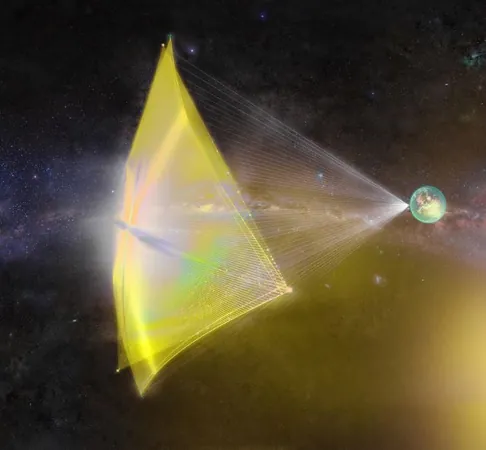
Revolutionary Nanomaterial Lightsails Could Redefine Space Exploration!
2025-03-26
Author: Ming
Introduction
Researchers from TU Delft in the Netherlands, in collaboration with Brown University in the USA, have made a groundbreaking advancement with the development of scalable nanotechnology-based lightsails that hold the potential to transform future space exploration endeavors, including ambitious missions to Mars.
Significant Leap in Technology
Published recently in the esteemed journal *Nature Communications*, this research marks a significant leap in the creation of the thinnest large-scale reflectors that humanity has ever engineered. These lightsails utilize laser-driven radiation pressure, an innovative method that allows spacecraft to accelerate to astonishing speeds. Unlike conventional nanotechnology that typically scales down devices on all fronts, these lightsails boast a unique design: they measure a mere 1/1000th the thickness of a human hair, yet can extend into impressively large sheets.
Prototype Development
The current prototype impressively measures 60mm x 60mm and stands at just 200 nanometres thick, adorned with billions of nanosized pores. This development underscores a monumental stride in fabrics that potential future missions could utilize. The groundbreaking approach combines neural topology optimization techniques with advanced fabrication methods, resulting in a cutting-edge prototype.
Expert Insights
Dr. Richard Norte, an associate professor at TU Delft, highlights the uniqueness of this material: “It’s not just its high aspect ratio that sets this material apart; it’s the innovative blend of large scale and nanoscale that makes it both remarkably lightweight and highly reflective.” This outstanding material has been made possible by a new gas-based etching technique, meticulously designed to remove excess materials under the sails, leaving behind an enduring structure. Norte also reassures that while manufacturing poses risks of breakage, once these sails are in position, they demonstrate remarkable strength.
Testing and Future Goals
Testing of these lightsails has already begun on a minute scale, measuring distances in picometers, with plans to push boundaries much further. Norte explained the ambitious vision: “If we were to scale up this technology, we could create a lightsail extending the length of seven football fields, only a millimeter in thickness. With this, we could theoretically send probes to Mars in a matter of days!” Although achieving such long distances remains a future goal, the team is diligently preparing experiments to test the sails’ capabilities on a smaller scale, hoping to measure propulsion over centimeters against Earth’s gravity.
Implications for Physics and Space Exploration
This research doesn’t merely reach for the stars; it opens new avenues for experimental physics as well. Accelerating masses to high velocities could lead to groundbreaking studies in light-matter interactions and relativistic physics at large scales.
Conclusion
Norte emphasizes the significance of this EU-funded project, stating, “This research places Delft at the cutting-edge of nanoscale material science. The capabilities we are discovering in nanofabrication, lasers, and design might prove as thrilling as the missions destined for explore beyond our solar system.” The future indeed looks bright, as this nanotechnology may soon launch humanity into an era of unparalleled discovery. Stay tuned as we continue to monitor this remarkable scientific journey!



 Brasil (PT)
Brasil (PT)
 Canada (EN)
Canada (EN)
 Chile (ES)
Chile (ES)
 Česko (CS)
Česko (CS)
 대한민국 (KO)
대한민국 (KO)
 España (ES)
España (ES)
 France (FR)
France (FR)
 Hong Kong (EN)
Hong Kong (EN)
 Italia (IT)
Italia (IT)
 日本 (JA)
日本 (JA)
 Magyarország (HU)
Magyarország (HU)
 Norge (NO)
Norge (NO)
 Polska (PL)
Polska (PL)
 Schweiz (DE)
Schweiz (DE)
 Singapore (EN)
Singapore (EN)
 Sverige (SV)
Sverige (SV)
 Suomi (FI)
Suomi (FI)
 Türkiye (TR)
Türkiye (TR)
 الإمارات العربية المتحدة (AR)
الإمارات العربية المتحدة (AR)